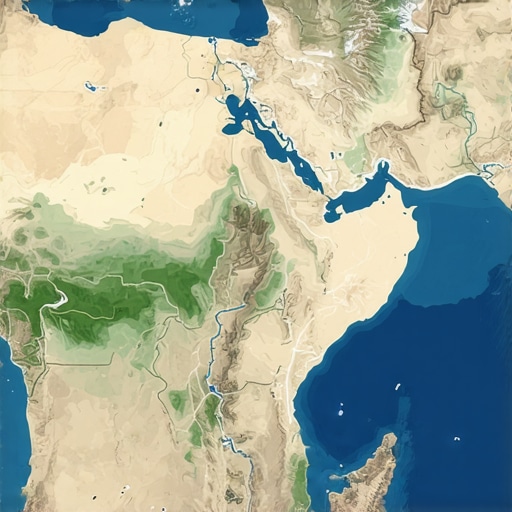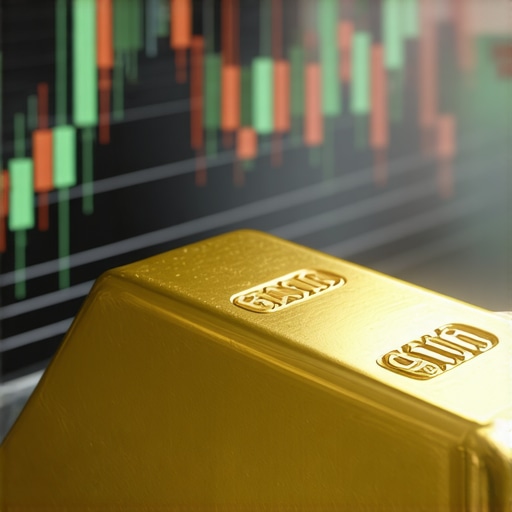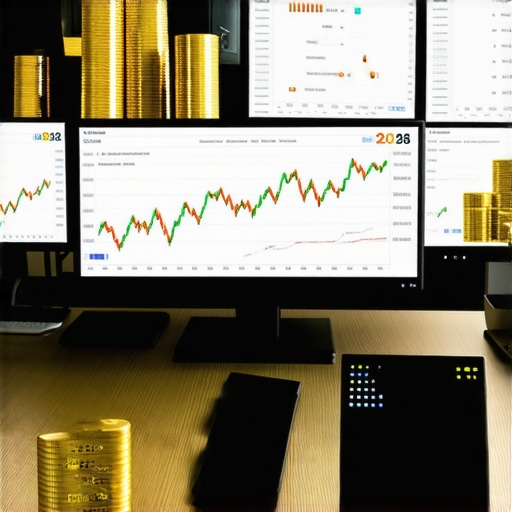Unveiling the Complexities of Gold Demand and Future Price Drivers in 2025
As global economic uncertainties persist, understanding the intricacies of gold demand and the multifaceted factors influencing its price becomes imperative for discerning investors. In 2025, the gold market stands at a crossroads, shaped by geopolitical shifts, monetary policies, and evolving investment strategies. This analysis delves into the nuanced drivers that will dictate gold’s trajectory and offers insights grounded in expert knowledge and market data.
Key Factors Shaping Gold Demand in 2025
How Will Central Bank Policies Influence Gold Accumulation?
Central banks remain pivotal in gold demand dynamics, with their purchasing behaviors reflecting macroeconomic stability or turmoil. Gold acquisitions by central banks, especially in major economies like China and Russia, are often viewed as a hedge against currency devaluation and inflation. Recent reports from the Bank for International Settlements highlight that these institutions continue to diversify reserves with gold, signaling sustained institutional interest.
What Role Does Jewelry and Industrial Demand Play in 2025?
Beyond investment, jewelry consumption and industrial applications contribute significantly to gold demand. Emerging markets, particularly India and China, are expected to maintain robust jewelry demand, driven by cultural factors and urbanization. Simultaneously, advancements in electronics and technology sectors will sustain industrial usage, although these are susceptible to supply chain disruptions and technological shifts.
Advanced Insights into Price Drivers for 2025
How Will Supply Constraints and Mining Output Affect Price Fluctuations?
Mine production levels and exploration activities directly impact gold supply. Experts forecast that geopolitical tensions and environmental regulations may constrain new mining projects, fostering a supply-side scarcity. This scarcity, combined with rising demand, is poised to exert upward pressure on prices, especially if geopolitical uncertainties escalate.
Can Macroeconomic Indicators Predict Gold Price Trends?
Economic indicators such as inflation rates, interest rate trajectories, and currency strength are crucial in forecasting gold prices. A weakening US dollar and rising inflation typically bolster gold, as investors seek safe-haven assets. Conversely, rising interest rates may dampen gold’s appeal due to opportunity cost considerations.
Expert Perspectives and Market Outlook
Market analysts suggest that gold’s role as a hedge against inflation and geopolitical risks will intensify in 2025. Portfolio diversification strategies incorporating long-term gold IRAs and physical assets are gaining traction among institutional and retail investors alike.
What Are the Key Uncertainties That Could Disrupt These Trends?
Unforeseen political crises, sudden shifts in monetary policy, or breakthroughs in alternative assets could alter the anticipated demand-supply balance. Staying informed through expert analyses and market reports is essential for adapting investment strategies.
If you aspire to deepen your understanding of gold’s evolving landscape, explore our comprehensive market analysis and price trend forecasts. Engage with fellow investors and contribute your insights to shape the future of gold investing.
Unpacking the Hidden Impacts of Geopolitical Tensions on Gold in 2025
While many investors focus on traditional macroeconomic indicators, the nuanced effects of geopolitical risks are often underestimated in their influence on gold demand. In 2025, escalating regional conflicts, trade tensions, and diplomatic crises could serve as catalysts that reshape investor behavior and market dynamics. These geopolitical uncertainties tend to heighten gold’s appeal as a safe haven, but understanding their layered impact requires a strategic perspective grounded in expert analysis.
How Do Political Instability and International Crises Drive Investment in Gold?
Political instability—be it in emerging markets, major economies, or regions with strategic importance—can trigger capital flight from riskier assets into gold. For instance, recent studies indicate that during periods of heightened tension, central banks and institutional investors accelerate gold purchases to safeguard reserves. Moreover, the geopolitical landscape influences currency stability, which in turn affects gold prices. Countries facing sanctions or diplomatic disputes may diversify reserves with gold, reinforcing its role as a hedge against currency devaluation and inflation.
For a comprehensive understanding of global reserve diversification, consult expert reports such as those provided by the Bank for International Settlements. Their data emphasizes that geopolitical risks are not only immediate catalysts but also long-term drivers of reserve management strategies.
Can Rising Tensions in Key Regions Alter Gold’s Market Trajectory?
Yes. Tensions in hotspots like the Middle East, Eastern Europe, or the South China Sea can cause sharp spikes in gold demand, especially if these conflicts threaten global supply chains or economic stability. Such regional crises often lead to increased demand for physical gold, such as coins and bars, as a tangible store of value. Additionally, disruptions in supply chains may further limit gold availability, adding upward pressure to prices.
Experts suggest that investors should monitor geopolitical developments closely, integrating this analysis into their broader market analysis frameworks to anticipate potential price swings.
How Can Investors Prepare for Geopolitical-Driven Volatility in Gold?
Preparation involves diversifying holdings within physical assets, ETFs, and mining stocks, and maintaining flexibility to adapt to sudden geopolitical shifts. Active monitoring of international news, diplomatic statements, and regional conflicts helps investors stay ahead of market disruptions. Moreover, incorporating expert tools like geopolitical risk indices can optimize timing and allocation decisions.
By aligning these strategies with insights from seasoned analysts, investors can better navigate the unpredictable landscape of 2025. For more detailed tactical advice, explore our best gold investment strategies for 2025.
Deciphering the Interplay of Geopolitical Risks and Gold Market Dynamics in 2025
As we delve deeper into 2025, it becomes increasingly evident that geopolitical tensions are not mere background noise but pivotal catalysts influencing gold’s market trajectory. These risks, ranging from regional conflicts to diplomatic stand-offs, have layered effects on investor sentiment, reserve diversification, and global economic stability. Understanding these complex interactions requires a nuanced perspective grounded in expert analysis and real-time data.
How Do Geopolitical Events Reshape Investor Strategies and Reserve Allocations?
Geopolitical crises often trigger a reassessment of risk, prompting institutional investors and central banks to pivot toward tangible assets like gold. For instance, during escalations in the Middle East or Eastern Europe, central banks in emerging markets tend to accelerate their gold purchases as a safeguard against currency devaluation and economic uncertainty. According to the Bank for International Settlements’ annual report (2025), reserve diversification with gold remains a core strategy amidst geopolitical turbulence, reflecting a strategic shift towards safe-haven assets.

Assessing the Long-Term Impact of Regional Conflicts on Gold Supply and Prices
Regional conflicts, especially in critical supply chain corridors, influence gold prices by constraining supply and elevating risk premiums. Disruptions in key mining regions or transportation routes elevate procurement costs and can cause supply shortages, further fueling price spikes. Experts emphasize that the geopolitical landscape’s unpredictability necessitates a dynamic approach to investment and risk management, often utilizing advanced predictive models that incorporate regional risk indices and supply chain analyses.
What Are the Emerging Trends in Gold Acquisition During Global Tensions?
Recent patterns indicate a surge in physical gold purchases—coins, bars, and jewelry—during periods of heightened tension, as investors seek tangible, portable stores of value. This shift is complemented by increased trading volumes in gold ETFs and derivatives, reflecting a broader strategic diversification. Data from the World Gold Council’s Gold Demand Trends (2025) highlight that such diversified demand sources are crucial in stabilizing prices amid volatile geopolitical climates.
To navigate this volatile landscape, investors are advised to stay informed through expert risk assessments and geopolitical analysis tools. For tailored strategies and in-depth insights, visit our comprehensive expert-guided resources on geopolitical risk management in gold investing.
Integrating Geopolitical Analysis into Gold Investment Frameworks
Effective investment in gold amidst geopolitical uncertainties requires integrating real-time geopolitical risk assessments into your strategic framework. This involves monitoring diplomatic developments, regional conflict escalation, and international sanctions that could influence supply chains and investor confidence. Advanced analytics, including machine learning models trained on geopolitical data, enable investors to anticipate market shifts with higher precision.
Furthermore, leveraging expert consultations and authoritative reports ensures that investment decisions are well-informed and adaptable. As the geopolitical landscape continues to evolve, ongoing education and strategic flexibility will remain vital for optimizing gold portfolios in 2025 and beyond.
Unraveling the Nuances of Gold Market Dynamics in 2025
As the global economic landscape continues to evolve amidst geopolitical tensions and shifting monetary policies, expert analysis becomes indispensable for understanding the intricate forces shaping gold demand and pricing. In 2025, the gold market is poised for complex interplay between supply constraints, investor behavior, and geopolitical developments, requiring a sophisticated approach to analysis and strategy.
How Do Central Bank Strategies Shape Gold Accumulation in Uncertain Times?
Central banks’ reserve management strategies are a critical determinant of gold demand. Recent data from the Bank for International Settlements suggest a continued trend of reserve diversification with gold, especially among emerging market economies seeking to hedge against currency volatility. These institutional movements reflect a broader shift toward tangible assets during times of macroeconomic uncertainty, influencing market liquidity and price stability.
Can Institutional Reserve Diversification Signal Price Trends?
Indeed, the strategic reserve diversification by central banks often precedes significant price movements, as large-scale accumulations can tighten supply and boost prices. Monitoring these reserve shifts provides valuable foresight into future market trajectories, an approach supported by expert analyses from financial research firms such as World Gold Council.
Engage with these insights to refine your investment approach, aligning with institutional trends and macroeconomic signals.
Industrial and Cultural Factors: Evolving Drivers of Gold Demand
Beyond investment, demand from jewelry markets and industrial sectors continues to influence overall gold consumption. In 2025, cultural factors, particularly in India and China, sustain robust jewelry demand, driven by urbanization and demographic shifts. Simultaneously, technological advancements in electronics and renewable energy sectors maintain industrial demand, although technological disruptions and supply chain vulnerabilities pose risks.
Supply Chain Constraints and Mining Output: Hidden Price Catalysts?
Mining activity and exploration investments are vital to gold supply stability. Geopolitical conflicts, environmental regulations, and resource depletion may constrain mine output, thereby creating a supply-side scarcity. Experts highlight that such constraints, coupled with rising demand, are likely to exert upward pressure on prices, especially if geopolitical tensions escalate further.
What Are the Future Trends in Gold Mining and Exploration?
Emerging trends indicate a shift toward sustainable mining practices and increased exploration in politically stable regions. Innovations in ore processing and recycling also contribute to supply resilience. For a comprehensive understanding, consult detailed reports from industry experts such as the World Gold Council.
Macroeconomic Indicators as Predictive Tools for Gold Price Movements
Inflation rates, interest rate trajectories, and currency strength are pivotal in forecasting gold price trends. A weakening US dollar and rising inflation typically incentivize gold investment, while rising interest rates may diminish its allure, reflecting opportunity costs. Advanced econometric models integrating these indicators offer nuanced market predictions for 2025.
Strategic Investment Approaches Amid Market Volatility
Investors should consider diversified portfolios that include physical gold, ETFs, and mining stocks to hedge against volatility. Staying informed through real-time geopolitical risk assessments and macroeconomic data enables proactive decision-making. Utilizing expert tools such as geopolitical risk indices enhances strategic agility, ensuring resilience in unpredictable markets.
Incorporating Geopolitical Risk into Gold Investment Frameworks
Integrating geopolitical analysis into investment strategies involves monitoring diplomatic developments, regional conflicts, and sanctions. Advanced analytical tools, including machine learning-based risk models, facilitate anticipatory actions that mitigate exposure to sudden market shocks. Regular engagement with expert reports, such as those from the Bank for International Settlements, ensures a comprehensive risk management approach.
Deeper Insights: How Geopolitical Tensions Shape Investor Behavior
Escalating regional conflicts often trigger a flight to safety, with institutional investors increasing gold acquisitions as a hedge against currency devaluation and economic instability. The layered impact of geopolitical risks extends beyond immediate market reactions, influencing long-term reserve strategies and global supply chains.
Understanding these complex interactions is essential for sophisticated investors seeking to capitalize on emerging opportunities while managing risks effectively.
What Are the Emerging Patterns in Gold Investment During Geopolitical Crises?
Data indicates a surge in physical gold purchases and heightened trading activity in derivatives and ETFs during geopolitical tensions. These patterns reflect a strategic shift toward tangible assets and diversified holdings, as documented in the World Gold Council’s reports.
To optimize your investment strategy, leverage expert analyses and predictive models that incorporate geopolitical risk factors, ensuring resilience amid global uncertainties.
Advancing Your Gold Investment Strategy with Expert Guidance
In a landscape marked by volatility and geopolitical complexities, continuous education and strategic flexibility are imperative. Incorporate real-time geopolitical risk assessments, supply chain analysis, and macroeconomic data into your decision-making process. Engaging with authoritative sources and expert consultations enhances your capacity to adapt swiftly and capitalize on emerging trends.
Expert Insights & Advanced Considerations
1. Central Bank Diversification Signals Future Price Movements
Expert analysis indicates that ongoing central bank diversification with gold signifies a strategic shift towards tangible reserves, often preceding significant price movements. Monitoring reserve data from sources like the Bank for International Settlements can provide foresight into potential market trends.
2. Geopolitical Risks as Catalysts for Supply Constraints
Regional conflicts and diplomatic tensions are increasingly constraining supply chains and mining outputs, which experts believe will exert upward pressure on gold prices. Active geopolitical risk assessment tools are essential for anticipating these disruptions.
3. Industrial and Cultural Demand Resilience
Despite macroeconomic uncertainties, cultural demand in India and China remains robust, coupled with technological advances in electronics and energy sectors that sustain industrial consumption, according to industry insiders.
4. Supply Chain Innovations and Sustainable Mining
Emerging trends focus on sustainable mining practices and recycling technologies, which experts see as vital for long-term supply stability amid environmental and geopolitical challenges.
5. Macro Indicators for Strategic Forecasting
Inflation trends, currency fluctuations, and interest rate policies continue to serve as key macroeconomic indicators, with specialized econometric models refining market predictions for 2025.
Curated Expert Resources
- Bank for International Settlements (BIS): Provides authoritative data on central bank reserve management and gold diversification trends.
- World Gold Council: Offers comprehensive reports on gold demand, supply, and market analysis, essential for strategic planning.
- Geopolitical Risk Assessment Tools: Advanced analytics platforms that monitor regional conflicts and diplomatic developments impacting supply chains.
- Industry Reports on Sustainable Mining: Insights into innovations in recycling and environmentally responsible exploration techniques.
- Econometric Models for Macro Indicators: Specialized forecasting tools integrating inflation, interest rates, and currency data for precise market predictions.
Final Expert Perspective
In 2025, the gold market is shaped by a complex interplay of geopolitical risks, macroeconomic shifts, and technological innovations. Staying ahead requires leveraging authoritative resources like the BIS and the World Gold Council while maintaining a strategic focus on supply chain resilience and macroeconomic indicators. As an investor or analyst, engaging with these insights and tools enhances your ability to navigate the evolving landscape of gold demand and pricing. For those committed to deepening their expertise, continuous education and strategic agility are your best assets—embrace them to optimize your position in 2025’s dynamic gold market.










